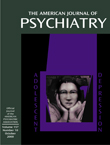Treatment of Patients With Delirium
To the Editor: Although we read with great interest the new “Practice Guideline for the Treatment of Patients With Delirium” (1), we strongly disagree on the dose recommendations for haloperidol. It is suggested to start with “1–2 mg every 2–4 hours as needed” and to titrate to higher doses in severely agitated patients because “bolus intravenous haloperidol doses exceeding 50 mg with total daily doses up to 500 mg…were associated with minimal effects on heart rate, respiratory rate, blood pressure, and pulmonary artery pressure and minimal extrapyramidal side effects” (1). Furthermore, the suggestion of a case-control study (Riker et al., 1994) that started “with a bolus dose of 10 mg [haloperidol intravenously] followed by continuous infusion at 5–10 mg/hour” is given without comment.
Although it is unequivocally acknowledged that typical antipsychotics act by means of blockade of brain dopamine D2 receptors, there is as yet no consensus as to what extent such a blockade is necessary to exert antipsychotic action. A threshold of 60% has been suggested, whereas a blockade of more than 80% of D2 receptors might convey only a higher risk for the development of neurological side effects with no further clinical improvement (2). Both [11C]raclopride with positron emission tomography (PET) and [123I]iodobenzamide with single photon emission computed tomography (SPECT) can be used to visualize and quantitatively analyze striatal dopamine D2 receptors in vivo.
Substantial levels of dopamine D2 receptor occupancy, ranging from 53% to 74%, were found with doses of 2 mg/day of haloperidol (2). In another PET study (3), 2–5 mg/day of haloperidol led to dose-dependent plasma levels from 0.5 to 5.8 ng/ml and to 53%–88% D2 receptor blockade. Accordingly, an [123I]iodobenzamide SPECT study also revealed a dose-dependent striatal D2 receptor occupancy of 63%–85% with 5–20 mg/day of haloperidol (4). In summary, those data suggest that it may not be wise to use daily doses of more than 10 mg of haloperidol. Clinical experience in schizophrenia supports this view. We are aware that the cited data were obtained from patients with schizophrenia. However, it is only fair to assume that nonschizophrenic patients would need approximately the same or even lower doses to establish antipsychotic efficacy. At this level, brain D2 receptors are most likely already saturated, so patients receiving higher doses are at high risk for more and unnecessary side effects. In cases of severe delirium that is unresponsive to an equivalent of 10 mg/day of haloperidol, one might consider the addition of substances with different mechanisms of action, e.g., glutamatergic or γ-aminobutyric acid medications.
1. American Psychiatric Association: Practice Guideline for the Treatment of Patients With Delirium. Am J Psychiatry 1999; 156(May suppl)Google Scholar
2. Kapur S, Remington G, Jones C, Wilson A, DaSilva J, Houle S, Zipursky R: High levels of dopamine D2 receptor occupancy with low-dose haloperidol treatment: a PET study. Am J Psychiatry 1996; 153:948–950Link, Google Scholar
3. Kapur S, Zipursky R, Roy P, Jones C, Remington G, Reed K, Houle S: The relationship between D2 receptor occupancy and plasma levels on low dose haloperidol: a PET study. Psychopharmacology (Berl) 1997; 131:148–152Crossref, Medline, Google Scholar
4. Tauscher J, Küfferle B, Asenbaum S, Fischer P, Pezawas L, Barnas C, Tauscher-Wisniewski S, Brücke T, Kasper S: In vivo 123I IBZM SPECT imaging of striatal dopamine-2 receptor occupancy in schizophrenic patients treated with olanzapine in comparison to clozapine and haloperidol. Psychopharmacology (Berl) 1999; 141:175–181Crossref, Medline, Google Scholar



